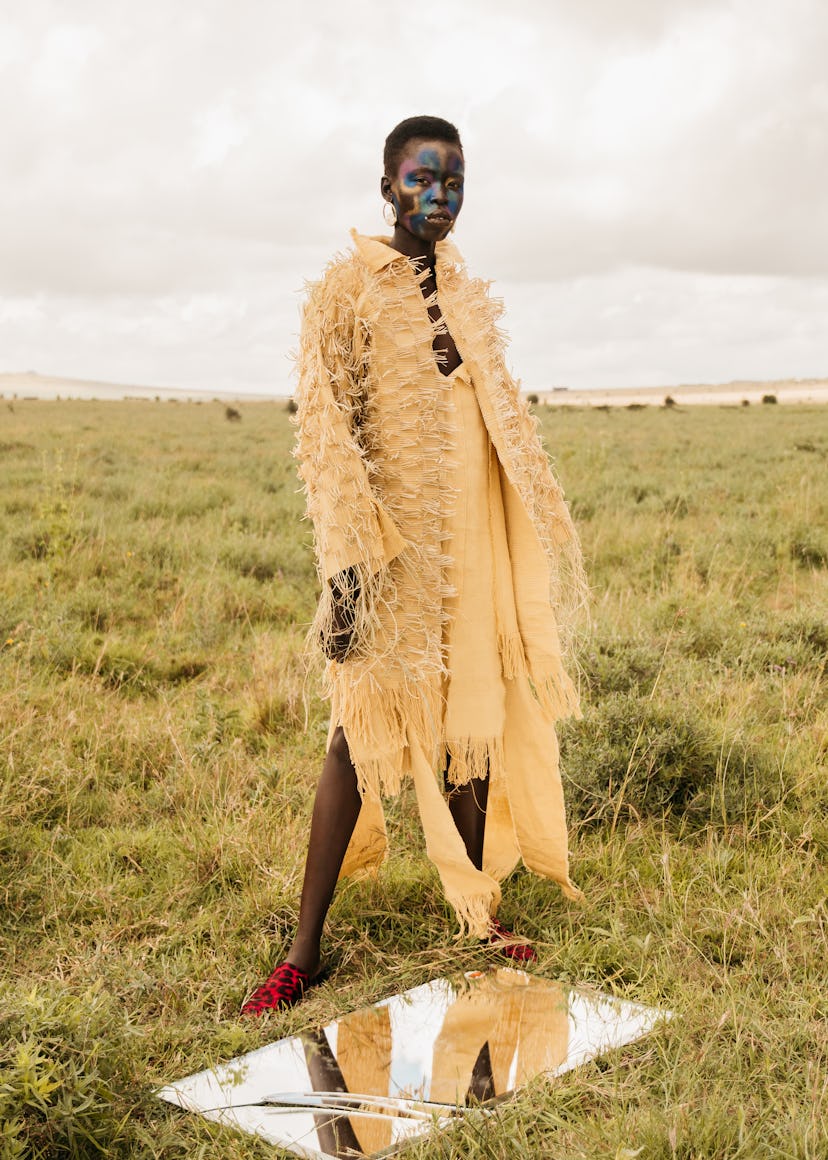When Bubu Ogisi first received an email asking her to be a part of the upcoming Africa Fashion exhibition opening on July 2nd at the Victoria and Albert Museum in London, she ignored it. “I was in the salt mines in Ghana, I was really busy working,” the Nigerian designer explains during a recent, slightly crackly, Zoom call.
Ogisi—who is the founder of IAMISIGO, an ethically produced pan-African womenswear brand dedicated to preserving and translating ancestral garment-making processes—tends to tune out when working on a new project. But after she’d finished speaking with the curators and organizers of Africa Fashion, Ogisi found herself looking forward to the possibilities this show could hold for African fashion and its rich history.
“I’ve been to the V&A museum, and every time I go there, there’s something missing. And I guess this is the piece to the puzzle that’s finally being added,” Ogisi says.
Africa Fashion has been curated to highlight the vibrant, layered, and inventive history of African fashion alongside the global influence of Africa’s contemporary fashions. Ogisi is slated to show her work in the contemporary fashions arm of the exhibition, alongside other designers of varying practices from across the continent, including Lagos Space Programme, Imane Ayissi, Moshions, Thebe Magugu, and Sindiso Khumalo.
A particular highlight of the African designers featured in this exhibition is the dedication to a practice of slow fashion that marries spirituality, history, heritage, and a value for utilizing our most immediate resources without causing serious damage to the life sources from where those materials were taken. This exhibition also marks a turning point for African fashion, which has seen a boom on the global stage, especially in the past five years. Fashion week events are scattered across the continent, African designers from Orange Culture to Kenneth Ize and Thebe Magugu are being worn by some of the world’s most influential personalities, with many of these designs go on to win coveted global fashion prizes and are stocked at reputable retail outfits.
This recent progress in the African fashion industry makes the exhibition a relevant study into Africa’s current state of fashion while providing a sense of what the future might come to look like.
Curated by Dr. Christine Checinska, the senior curator of African and African diaspora textiles and fashion at the V&A, Africa Fashion is set to have more than 250 objects on display, traveling across artistic mediums including garments, photography, film, catwalk footage, and editorial spreads. A number of the garments on show are from the personal archives of a selection of iconic 20th-century African designers—Shade Thomas-Fahm, Chris Seydou, Kofi Ansah, and Alphadi among them—marking the first time their work will be shown in a London museum.
This show will provide a comprehensive timeline of the evolution of African fashion on the continent; exploring vital themes such as the intersection of politics and social commentary with clothing, the place of colonialism and neo-colonialism in Africa’s fashion language, and the practice of drawing inspiration from different parts of the continent.
“We hope to give our audiences a glimpse of the glamor and the politics of the African fashion scene, a scene that is as diverse as the continent itself,” Dr. Checinska says.
Alongside Bubu Ogisi, 2021 LVMH Prize semifinalist and founder of Lagos Space Programme Adeju Thompson will be featured in the contemporary arm of the exhibition. Thompson, who describes Lagos Space Programme as a “contemporary genderless label exploring multidisciplinary collaborative futures,” will be showcasing pieces and garments from his 2021 collection, Project 5.
“Pieces in the collection include post-Adire, lab coats, dresses, knitted post-Adire tank tops, Adire muse, and Yoruba wide trousers, which are a replica of traditional Yoruba workwear trousers,” Thompson says.
The 31-year-old designer, who draws his tailoring inspirations from traditional Yoruba dressing and the ideas of gender and sexuality, is particularly interested in his offering at the exhibition providing a look into the history of queerness in Africa, and shining light on a history many consider nonexistent.
Ogisi, who explains this exhibition ties in with her ethos of decolonizing spaces, will be showing select pieces from her fall 2020 collection, titled Chasing Evil. For this collection, which plays with recycled cotton and traditional Congolese raffia fabrics, she was inspired by the long period of time she spent in Congo working in refugee camps, mostly assisting in rehabilitation centers for female victims harmed by the war. She wanted to use fashion as a form of protection, drawing inspiration from deities and other historical figurines that were used for protection and warding off evil in the past.
Ogisi is also showing pieces from her 2019 collection, gods of the wilderness—one that she says explores “the monophonic relationships between masquerades and animals.”
At a time when many parts of the African continent are slowly repairing their previously unstable relationship with preserving history and proper documentation, this exhibition ensures African fashion’s lesser-known histories are wrestled out of complete erasure.
